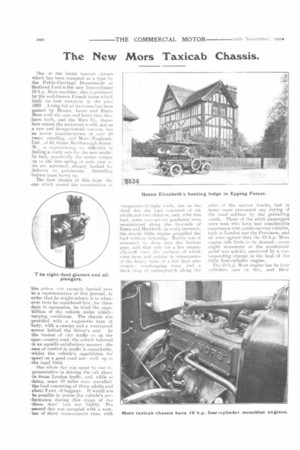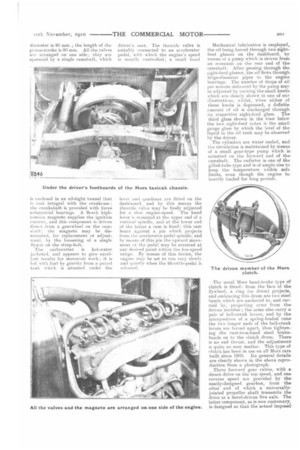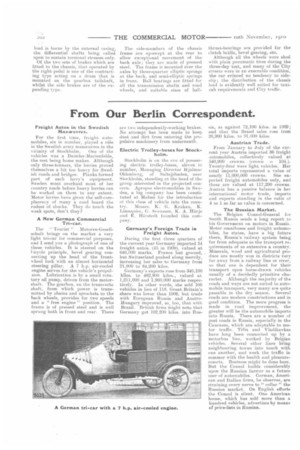The New Mors Taxicab Chassis.
Page 12

Page 13

Page 14

If you've noticed an error in this article please click here to report it so we can fix it.
One of the latest taxicab chassis -which has been accepted as a type by -the Public-Carriage Department at Scotland Yard is the new four-cylinder 10 h.p. More machine ; this is produced by the well-known French house which built its first motorcar in the year 1889. 1 long list of successes has been :gained by Messrs. Louis and Emile More with the cars and boats that they Isive built, and the Mors Co. there-lore enters the motorcah world, not as -a new and inexperienced concern, but -as motor manufacturers of over 2r1 years standing, and Mors (England), -Ltd., of 4.5, Great Marlborough Street, is experiencing no difficulty in -finding a ready sale for the new model. In fact, practically the entire output -up to the late spring of next year is, we are inforined, already booked for ,delivery to purchasers. Intending ...buyers must hurry up.
The first chassis of this typethe one which passed the examination of
the police, was recently handed over to a representative of this journal, in -order that he might submit it to what-ever tests he eonsidered fair ; for three -days in succession, he tried the capabilities of the vehicle under widely-varying conditions. The chassis was -provided with a wagonette type of 'body, with a canopy and a waterproof screen behind the driver's seat. In -the busiest of city traffic or on the open country road, the vehicle behaved -in an equally-satisiaetory mariner : the nease of control in traffic is remarkable, 'whilst the vehicle's capabilities for -speed on a good road are--well, up to
he legal limit.
One whole (lay was spent liv our representative in driving the cab about in dense London traffic, and, while w 'doing, some 50 miles were travelled. the load consisting of three adults and about 2 cwt. of luggage. Tt would not be possible to praise the vehicle's per-lormance during this stage of the three days' test too highly. The -second day was occupied with a number of short cross-country runs, with comparatively-light loads, but on the third day the load consisted of six adults and two children, and, with this load, sonic very-severe gradients were encountered along the by-roads of Essex and Hertford : in every instance, the sturdy little engine propelled the load without falteriag. Rarely was it II ecessary to drop into the bottom gear, and that only for a few linusiially-siiff rises. the surfaces; of which were loose and sodden in consequence of the !wavy rains or a few days previously ; overhangiug trees. and a thick crop of nialergrowth along the sides of the narrow tracks, had in many cases prevented any drying of the road surface by the prevailing winds. Three of the adult passengers were men who have had considerable experience with public-service vehicles, both in London and the Provinces, and all were agreed that the 10 h.p. Mors engine left little to be desired: every :slight movement of the accelerator pedal was quickly answered by a corresponding change in the beat of the little four-cylinder engine.
The 10 11.p. Mors engine has its four cylinders cast en Nor, and their diameter is 80 mm.; the length of the piston-stroke is 90 mm. All the valves are arranged on one side; they are operated by a single camshaft, which is cuclosed in an oil-tight tunnel that is cast integral with the crankcase ; the crankshaft is provided with three substantial bearings. A Bosch hightension magneto supplies the ignition current, and this component is driven direct from a gearwheel on the camshaft ; the magneto may be dismounted, for replacement or adjustment, by the loosening of a single flyntat on the strap-bolt.
The carburetter is hot-water jacketed, and appears to give excellent results for motorcab work ; it is fed with fuel by gravity from a petrol tank which is situated under the driver's seat. The throttle valve is suitably connected to an accelerator pedal, with which the engine's speed is usually controlled; a small hand
lever a ed quadrant are fitted on the dashboard, and by this means the throttle valve may be finely adjusted for a slow engine-speed. The hand lever is mounted at the upper end of a vertical spindle, and at the lower end of the latter a cam is fixed ; this cam bears against, a pin which projects front the accelerator-pedal spindle, and by nieans of this pin the upward movement if the pedal may be arrested at any desired point within the low-speed range. By means of this device, the engine may be set to run very slowly and quietly when the throttle-pedal is rel Self . Mechanical lubrication is employed, the oil being forced through two sightfeed glasses on the dashboard, by means of a pump which is driven from an eccentric on the rear end of the camshaft. After passing through the sight-feed glasses, the oil flows through large-diameter pipes to the engine bearings. The number of drops of oil. perminute delivered by the pump maybe adjusted by turning the small knob& which are clearly shown in one of our illustrations, whilst, when either of these knobs is depressed, a definite amount of nil is discharged through its respective sight-feed glass. The third glass shown in the view belowthe two sight-feed tubes is the small gauge glass by which the level of theliquid in the oil tank may be observed by the driver.
The cylinders are water cooled, and the circulation is maintained by means of a small gear-type pump which is, mounted on the forward end of the camshaft. The radiator is one of the gilled-tube type and is of ample size to keep the temperature within safe limits, even though the engine beheavily loaded for long periods.
The usual More band-brake type of clutch is fitted : from the face of the flywheel, a ring (or drum) projects, and embracing this drum are two steer bands which are anchored to, and carried by, projecting arms from the driven member ; the arms also carry a pair of bell-crank levers, and by the interposition of a spring-loaded cone the two longer ends of the bell-crank levers are forced apart, thus tightening the cast-iron-lined steel brakebands on to the clutch drum. There is no end thrust, and the adjustment is quite an easy matter. This type of clutch has been in use on all Mors cars built since 1005. Its general details are clearly shown in the above reproduction from a photograph. Three forward gear ratios, with a direct drive on the top speed, and one reverse speed are provided by the neatly-designed gearbox, from the after end of which a universallyjointed propeller shaft transmits the drive to a bevel-driven live axle. Thelatter component, as is now customary, is designed so -that the actual imposed
load -is borne by the external casing, the differential shafts being called upon to sustain torsional stresses only. Of the two sets of brakes which are fitted to the chassis, that operated by the right pedal is one of the contracting type acting on a drum that is mounted on the gearbox tailshaft, whilst the side brakes are of the expanding type.
The side-members of the chassis frame are up-swept at the rear to allow exceptional movement of the back axle ; they are made of pressed steel. The frame is mounted over the axles by three-quarter elliptic springs at the back, and semi-elliptic springs in front. Bail bearings are fitted for all the transmission shafts and road wheels, and suitable sizes of ball thrust-bearings are provided for the clutch bridle, bevel gearing, etc.
Although all the wheels were shod with plain pneumatic tires during the three-day test, and many of the City streets were in an execrable condition, the car evinced no tendency to sideslip; the distribution of the chassis load is evidently well suited for taxicab requirements and City traffic.




















